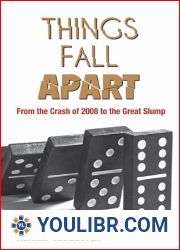
BOOKS - Things Fall Apart: From the Crash of 2008 to the Great Slump

Things Fall Apart: From the Crash of 2008 to the Great Slump
The crash of 2008, when financial markets came to a standstill, has had profound effects that are still being felt globally. Five years after those dramatic events, countries such as Greece, Spain, Italy, Portugal, and Cyprus are still reeling from the aftereffects of the financial crash, while the USA and the UK continue to be in the grip of a long slump.The crash exposed criminal swindles and the more rampant risky practices that have become the norm with the major banks. It has also revealed the failure of policy to curb unbridled risk taking with other people's money and the failure of policy-makers and economists to see the signs of the inevitable collapse.This book goes further to penetrate the fog of finance and explore the structure and balance of class forces that led to the crisis and its unfolding consequences. The author places the crisis in both historical and global perspectives through comparisons with the Great Depression and the focus on elaborating the role of the hegemony of the dollar over the international financial system. She argues that the crisis is as much a crisis of the neoliberal model of accumulation that finance launched as it is of the mechanisms by which dollar hegemony was preserved.This book provides an accessible point of entry to the literature on the crisis and its aftermath. It lays out a rich empirically grounded analysis of both the structural causes and the continuing repercussions of the crash of financial markets in 2008.
Things Fall Apart: From the Crash of 2008 to the Great Slump Einführung Seit dem Finanzcrash 2008 ist die Welt nicht mehr dieselbe. Die dramatischen Ereignisse dieses Jahres haben auf der ganzen Welt Umwälzungen ausgelöst, so dass sich viele Länder immer noch nicht von den Folgen erholt haben. Der Zusammenbruch enthüllte die kriminellen Machenschaften und riskanten Praktiken, die in Großbanken zur Norm geworden sind, und offenbarte die Unfähigkeit der Politik, das ungezügelte Risiko durch das Geld anderer zu zügeln. Dieses Buch taucht tief in den Nebel der Finanzen ein und untersucht die Struktur und das Gleichgewicht der Klassenkräfte, die zur Krise und ihren sich entfaltenden Folgen geführt haben. Kapitel 1: Die Ursachen der Krise Der Crash von 2008 war nicht nur ein zufälliges Ereignis, sondern der Höhepunkt einer jahrzehntelangen neoliberalen Politik, die die Interessen der Reichen und nicht das Wohlergehen der Massen in den Vordergrund stellte. Die Deregulierung des Finanzsektors, das Anwachsen der spekulativen Finanzen und die Hegemonie des Dollars als Weltreservewährung haben alle zur Krise beigetragen. Things Fall Apart:從2008的崩潰到大滿貫介紹,自2008金融危機以來,世界從未如此。那的戲劇性事件在全球範圍內引起了動蕩,導致許多國家仍未從後果中恢復過來。這次倒閉暴露了犯罪欺詐和冒險行為,這些行為已成為大型銀行的常態,揭示了政客無法用別人的錢遏制肆無忌憚的風險。這本書深入探討了金融的迷霧,探討了導致危機及其不斷發展的後果的階級力量的結構和平衡。第一章:危機的起因2008的崩潰不僅僅是一個偶然的事件,而是幾十新自由主義政策的高潮,這些政策將富人的利益而不是群眾的福利放在首位。放松對金融部門的管制,投機性金融的興起以及美元作為世界儲備貨幣的霸權,都助長了危機。
דברים מתפרקים: מהתרסקות 2008 ועד למבוא השפל הגדול העולם מעולם לא היה אותו הדבר מאז ההתרסקות הפיננסית של 2008. האירועים הדרמטיים של אותה שנה שלחו גלי הלם ברחבי העולם, והותירו מדינות רבות עדיין נרגעות מהנשורת. הקריסה חשפה את התעלולים הפליליים והפרקטיקות המסוכנות שהפכו לנורמה בבנקים הגדולים, וחשפה את הכישלון של הפוליטיקה לרסן סיכון בלתי מרוסן עם כסף של אחרים. הספר הזה מתעמק בערפל הפיננסי, בוחן את המבנה והמאזן של כוחות המעמדות שהובילו למשבר ולתוצאות שלו. פרק 1: הגורמים למשבר ההתרסקות של 2008 לא היו רק אירוע אקראי, אלא שיאם של עשרות שנים של מדיניות ניאו-ליברלית אשר נתנה עדיפות לאינטרסים של העשירים על פני רווחת ההמונים. הסרת הפיקוח על המגזר הפיננסי, עליית המימון הספקולטיבי והגמוניה של הדולר כמטבע הרזרבי העולמי תרמו כולם למשבר. الأشياء تنهار: من انهيار عام 2008 إلى مقدمة الركود العظيم لم يكن العالم كما كان منذ الانهيار المالي لعام 2008. تسببت الأحداث الدرامية في ذلك العام في حدوث موجات صدمة في جميع أنحاء العالم، تاركة العديد من البلدان لا تزال تعاني من التداعيات. كشف الانهيار عن الخدع الإجرامية والممارسات المحفوفة بالمخاطر التي أصبحت القاعدة في البنوك الكبرى، وكشف عن فشل السياسة في الحد من المخاطر الجامحة بأموال الآخرين. يتعمق هذا الكتاب في ضباب التمويل، ويفحص هيكل وتوازن القوى الطبقية التي أدت إلى الأزمة وتداعياتها. الفصل 1: أسباب الأزمة لم يكن الانهيار 2008 مجرد حدث عشوائي، بل كان تتويجًا لعقود من السياسات النيوليبرالية التي أعطت الأولوية لمصالح الأغنياء على رفاهية الجماهير. ساهم في الأزمة تحرير القطاع المالي، وصعود تمويل المضاربة، وهيمنة الدولار كعملة احتياطية في العالم. Things Fall Apart: From the Crash of 2008 to the Great Slump Introduction The world has never been the same since the financial crash of 2008. The dramatic events of that year sent shockwaves across the globe, leaving many countries still reeling from the aftereffects. The crash exposed criminal swindles and risky practices that had become the norm in the major banks, revealing the failure of policy to curb unbridled risk-taking with other people's money. This book delves into the fog of finance, exploring the structure and balance of class forces that led to the crisis and its unfolding consequences. Chapter 1: The Causes of the Crisis The crash of 2008 was not just a random event, but rather the culmination of decades of neoliberal policies that prioritized the interests of the wealthy over the well-being of the masses. The deregulation of the financial sector, the rise of speculative finance, and the hegemony of the dollar as the global reserve currency all contributed to the crisis. Things Fall Apart: From the Crash of 2008 to the Great Slump Introduction Мир никогда не был прежним после финансового краха 2008 года. Драматические события того года вызвали потрясения по всему земному шару, в результате чего многие страны все еще не оправились от последствий. Крах выявил преступные махинации и рискованные практики, которые стали нормой в крупных банках, выявив неспособность политики обуздать необузданный риск чужими деньгами. Эта книга углубляется в туман финансов, исследуя структуру и баланс классовых сил, которые привели к кризису и его разворачивающимся последствиям. Глава 1: Причины кризиса Крах 2008 года был не просто случайным событием, а скорее кульминацией десятилетий неолиберальной политики, которая ставила во главу угла интересы богатых, а не благосостояние масс. Дерегулирование финансового сектора, рост спекулятивных финансов и гегемония доллара как мировой резервной валюты - все это способствовало кризису. 物事が離れて落ちる:2008のクラッシュから大スランプへはじめに世界は2008の金融クラッシュ以来、決して同じではありませんでした。そのの劇的な出来事は世界中に衝撃を与え、多くの国が依然として落下から巻き戻しています。この崩壊は、大銀行の規範となっている犯罪者のシェナニガンと危険な慣行を露呈させ、政治が他人のお金で大きなリスクを抑制できなかったことを明らかにした。本書は、危機とその後の展開につながった階級勢力の構造とバランスを検討し、金融の霧を掘り下げます。第1章:危機の原因2008の暴落は、単なるランダムな出来事ではなく、大衆の福祉に対する富裕層の利益を優先した数十にわたる新自由主義政策の集大成でした。金融部門の規制緩和、投機金融の上昇、そして世界の準備通貨としてのドルの覇権は、すべて危機に貢献した。 사물이 떨어짐: 2008 년의 충돌에서 그레이트 슬럼프 소개에 이르기까지 2008 년 금융 위기 이후 세계는 결코 같지 않았습니다. 그해의 극적인 사건은 전 세계에 충격파를 보냈으며 많은 국가들이 여전히 낙진에서 벗어나고 있습니다. 이 붕괴는 큰 은행의 표준이 된 범죄 셰나 니건과 위험한 관행을 폭로하여 정치가 다른 사람들의 돈으로 무자비한 위험을 억제하지 못하는 것을 드러냈다. 이 책은 금융의 안개를 탐구하여 위기와 그 여파로 이어진 계급 세력의 구조와 균형을 조사합니다. 1 장: 위기의 원인 2008 년 충돌은 단지 무작위 사건이 아니라 대중의 복지보다 부자의 이익을 우선시하는 수십 년의 신자유주의 정책의 정점이었습니다. 금융 부문의 규제 완화, 투기 금융의 부상 및 세계 준비 통화로서의 달러의 패권은 모두 위기에 기여했습니다. Rzeczy się rozpadają: Od katastrofy 2008 do wielkiego wprowadzenia Slump Świat nigdy nie był taki sam od katastrofy finansowej 2008. Dramatyczne wydarzenia z tamtego roku wywołały wstrząsy na całym świecie, pozostawiając wiele krajów w ciągłym tempie. Upadek ujawnił kryminalne szenanigany i ryzykowne praktyki, które stały się normą w dużych bankach, ujawniając niepowodzenie polityki w ograniczaniu nieokiełznanego ryzyka z pieniędzy innych ludzi. Książka ta zagłębia się w mgłę finansów, badając strukturę i równowagę sił klasowych, które doprowadziły do kryzysu i jego następstw. Rozdział 1: Przyczyny kryzysu Katastrofa 2008 była nie tylko przypadkowym wydarzeniem, ale raczej kulminacją dekad neoliberalnej polityki, która priorytetowo traktowała interesy bogatych nad dobrobytem mas. Deregulacja sektora finansowego, wzrost spekulacyjnych finansów oraz hegemonia dolara jako światowej waluty rezerwowej przyczyniły się do kryzysu. Things Fall Apart: From the Crash of 2008 to the Great Slump Giriş Dünya, 2008 finansal çöküşünden bu yana hiçbir zaman aynı olmadı. O yılın dramatik olayları, dünyanın dört bir yanına şok dalgaları gönderdi ve birçok ülkeyi hala serpintiden sarstı. Çöküş, büyük bankalarda norm haline gelen cezai maskaralıkları ve riskli uygulamaları ortaya çıkardı ve siyasetin diğer insanların parasıyla dizginsiz riski azaltma konusundaki başarısızlığını ortaya koydu. Bu kitap, krize ve sonrasına yol açan sınıf güçlerinin yapısını ve dengesini inceleyerek finansın sisini inceliyor. Bölüm 1: Krizin Nedenleri 2008 çöküşü sadece rastgele bir olay değil, zenginlerin çıkarlarını kitlelerin refahı üzerinde önceleyen onlarca yıllık neoliberal politikaların doruk noktasıydı. Finans sektörünün serbestleşmesi, spekülatif finansın yükselişi ve dünyanın rezerv para birimi olarak doların hegemonyası krize katkıda bulundu. Things Fall Apart: From the Crash of 2008 to the Great Slump Intrudition O mundo nunca foi o mesmo desde o colapso financeiro de 2008. Os acontecimentos dramáticos daquele ano causaram transtornos em todo o mundo, fazendo com que muitos países ainda não se recuperassem das consequências. O colapso revelou fraudes criminosas e práticas de risco que se tornaram normais em grandes bancos, revelando a incapacidade da política de conter o risco desmedido com dinheiro alheio. Este livro está se aprofundando no nevoeiro das finanças, explorando a estrutura e o equilíbrio das classes que levaram à crise e suas consequências. Capítulo 1: As causas da crise O colapso de 2008 não foi apenas um acontecimento acidental, mas sim o culminar de décadas de políticas neoliberais que colocaram os interesses dos ricos no topo, e não o bem-estar das massas. A desregulamentação do setor financeiro, o aumento das finanças especulativas e a hegemonia do dólar como moeda de reserva mundial contribuíram para a crise. pobierz plik pdf Wszystko spada Poza katastrofą 2008 do Wielkiej Recesji PDFファイルをダウンロード すべてが2008の暴落から大景気後退へと落ちる تنزيل ملف pdf كل شيء يسقط بعيدًا عن انهيار 2008 إلى الركود العظيم 下载 pdf 文件 從2008崩潰到大衰退,一切都崩潰了
להוריד קובץ PDF הכל מתפרק מהתרסקות 2008 למיתון הגדול descarregar ficheiro pdf Tudo desmorona desde o colapso de 2008 até a grande recessão PDF-Datei herunterladen Vom Crash 2008 bis zur großen Rezession fällt alles auseinander Scarica il file pdf Tutto crolla dal crollo del 2008 alla grande recessione download pdf file télécharger le fichier pdf Tout s'effondre de l'effondrement de 2008 à la grande récession download pdf file Things Fall Apart: From the Crash of 2008 to the Great Slump pdf dosyasını indir 2008 Çöküşünden Büyük Durgunluğa Kadar Her Şey Ayrı Düşüyor descargar archivo pdf Todo se desmorona desde el colapso de 2008 hasta la gran recesión скачать файл PDF Все разваливается от краха 2008 года до великого спада pdf 파일 다운로드 2008 년 추락에서 대 불황으로 넘어지는 모든 것
Der Crash von 2008, als die Finanzmärkte zum Erliegen kamen, hatte tiefgreifende Auswirkungen, die weltweit immer noch spürbar sind. Fünf Jahre nach diesen dramatischen Ereignissen schwanken Länder wie Griechenland, Spanien, Italien, Portugal und Zypern immer noch unter den Folgen des Finanzcrashs, während die USA und Großbritannien weiterhin einem langen Abschwung ausgesetzt sind. Der Zusammenbruch offenbarte kriminelle Machenschaften und hemmungslosere riskante Praktiken, die für Großbanken zur Norm geworden sind. Es zeigte auch die Unfähigkeit der Politik, das ungezügelte Risiko des Geldes anderer Leute einzudämmen, und die Unfähigkeit von Politikern und Ökonomen, Anzeichen für einen bevorstehenden Zusammenbruch zu erkennen. Dieses Buch geht weiter, um in den Nebel der Finanzen einzudringen und die Struktur und das Gleichgewicht der Klassenkräfte zu untersuchen, die zur Krise und ihren sich entfaltenden Folgen geführt haben. Der Autor stellt die Krise sowohl in eine historische als auch in eine globale Perspektive durch den Vergleich mit der Großen Depression und den Fokus auf die Untersuchung der Rolle der Hegemonie des Dollars über das internationale Finanzsystem. Sie argumentiert, dass die Krise genauso eine Krise des neoliberalen Akkumulationsmodells ist, das die Finanzierung ausgelöst hat, wie die Mechanismen, mit denen die Dollar-Hegemonie aufrechterhalten wurde. Dieses Buch bietet einen zugänglichen Einstieg in die Literatur über die Krise und ihre Folgen. Es enthält eine reiche empirisch fundierte Analyse sowohl der strukturellen Ursachen als auch der anhaltenden Auswirkungen des Zusammenbruchs der Finanzmärkte im Jahr 2008.
O colapso de 2008, quando os mercados financeiros pararam, teve um impacto profundo que ainda é sentido em todo o mundo. Cinco anos depois destes acontecimentos dramáticos, países como Grécia, Espanha, Itália, Portugal e Chipre ainda estão a passar pelos efeitos do colapso financeiro, enquanto os Estados Unidos e o Reino Unido continuam no poder de uma longa recessão. O colapso revelou fraudes criminosas e práticas de risco mais desenfreadas que se tornaram normais para grandes bancos. Isso também revelou a incapacidade da política de conter o risco desmedido do dinheiro dos outros e a incapacidade de políticos e economistas de ver sinais de um colapso inevitável. Este livro vai além para penetrar no nevoeiro das finanças e explorar a estrutura e o equilíbrio das forças de classe que levaram à crise e suas consequências. O autor coloca a crise na perspectiva histórica e global através de uma comparação com a Grande Depressão e um foco na elaboração do papel da hegemonia do dólar sobre o sistema financeiro internacional. Ela afirma que a crise é a mesma crise do modelo neoliberal de poupança que o financiamento lançou, assim como os mecanismos que mantiveram a hegemonia do dólar. Este livro oferece um ponto de entrada acessível na literatura sobre a crise e suas consequências. Ele apresenta uma rica análise experiencial, tanto das causas estruturais como dos efeitos contínuos do colapso dos mercados financeiros em 2008.
L'effondrement de 2008, lorsque les marchés financiers se sont arrêtés, a eu un impact profond qui se fait encore sentir dans le monde entier. Cinq ans après ces événements dramatiques, des pays comme la Grèce, l'Espagne, l'Italie, le Portugal et Chypre sont toujours fragilisés par les conséquences de l'effondrement financier, tandis que les États-Unis et la Grande-Bretagne continuent d'être en proie à une récession prolongée. L'effondrement a révélé des fraudes criminelles et des pratiques risquées plus rampantes qui sont devenues la norme pour les grandes banques. Cela a également mis en évidence l'incapacité des politiques à juguler le risque débridé de l'argent des autres et l'incapacité des politiciens et des économistes à voir des signes d'effondrement inévitable. Ce livre va plus loin dans le brouillard de la finance et explore la structure et l'équilibre des forces de classe qui ont conduit à la crise et à ses conséquences. L'auteur place la crise dans une perspective historique et mondiale en comparant avec la Grande Dépression et en se concentrant sur le rôle de l'hégémonie du dollar sur le système financier international. Elle affirme que la crise est la même crise du modèle néolibéral d'accumulation que le financement a lancé que les mécanismes par lesquels l'hégémonie du dollar a été maintenue. Ce livre fournit un point d'entrée accessible à la littérature sur la crise et ses conséquences. Il présente une riche analyse empirique des causes structurelles et des effets continus de l'effondrement des marchés financiers en 2008.
Il crollo del 2008, quando i mercati finanziari si fermarono, ebbe un impatto profondo che ancora si percepisce in tutto il mondo. Cinque anni dopo questi drammatici eventi, paesi come Grecia, Spagna, Italia, Portogallo e Cipro continuano a fluttuare per le conseguenze del crollo finanziario, mentre gli Stati Uniti e il Regno Unito continuano ad essere al potere di una lunga recessione. Il crollo ha rivelato frodi criminali e pratiche di rischio più spropositate, che sono diventate la norma per le grandi banche. Ciò ha anche messo in luce l'incapacità della politica di arginare il rischio spropositato sul denaro degli altri e l'incapacità dei politici e degli economisti di vedere i segni di un crollo inevitabile. Questo libro va oltre per penetrare nella nebbia della finanza e esplorare la struttura e l'equilibrio delle forze di classe che hanno portato alla crisi e le sue conseguenze in corso. L'autore colloca la crisi in una prospettiva storica e globale attraverso il confronto con la Grande Depressione e il focus sulla ricerca del ruolo dell'egemonia del dollaro sul sistema finanziario internazionale. Sostiene che la crisi sia la stessa crisi del modello neoliberale di risparmio che i finanziamenti hanno avviato, come i meccanismi con cui è stata mantenuta l'egemonia del dollaro. Questo libro fornisce un punto di ingresso disponibile nella letteratura sulla crisi e le sue conseguenze. Fornisce una ricca analisi esperienziale sia delle cause strutturali che delle conseguenze del crollo dei mercati finanziari nel 2008.
The crash of 2008, when financial markets came to a standstill, has had profound effects that are still being felt globally. Five years after those dramatic events, countries such as Greece, Spain, Italy, Portugal, and Cyprus are still reeling from the aftereffects of the financial crash, while the USA and the UK continue to be in the grip of a long slump.The crash exposed criminal swindles and the more rampant risky practices that have become the norm with the major banks. It has also revealed the failure of policy to curb unbridled risk taking with other people's money and the failure of policy-makers and economists to see the signs of the inevitable collapse.This book goes further to penetrate the fog of finance and explore the structure and balance of class forces that led to the crisis and its unfolding consequences. The author places the crisis in both historical and global perspectives through comparisons with the Great Depression and the focus on elaborating the role of the hegemony of the dollar over the international financial system. She argues that the crisis is as much a crisis of the neoliberal model of accumulation that finance launched as it is of the mechanisms by which dollar hegemony was preserved.This book provides an accessible point of entry to the literature on the crisis and its aftermath. It lays out a rich empirically grounded analysis of both the structural causes and the continuing repercussions of the crash of financial markets in 2008.
El colapso de 2008, cuando los mercados financieros se detuvieron, tuvo un profundo impacto que aún se siente en todo el mundo. Cinco años después de estos dramáticos acontecimientos, países como Grecia, España, Italia, Portugal y Chipre siguen tambaleándose por los efectos del colapso financiero, mientras Estados Unidos y el Reino Unido siguen a merced de una larga recesión. El colapso ha revelado fraudes criminales y prácticas de riesgo más desenfrenadas que se han convertido en la norma para los grandes bancos. También puso de manifiesto la incapacidad de la política para frenar el riesgo desenfrenado del dinero ajeno y la incapacidad de los políticos y economistas para ver señales de un colapso inevitable. Este libro va más allá para penetrar en la niebla de las finanzas y explorar la estructura y el equilibrio de las fuerzas de clase que llevaron a la crisis y sus desenvolvimientos. El autor sitúa la crisis en una perspectiva tanto histórica como global a través de una comparación con la Gran Depresión y un enfoque en la elaboración del papel de la hegemonía del dólar sobre el sistema financiero internacional. Sostiene que la crisis es la misma crisis del modelo neoliberal de acumulación que la financiación ha puesto en marcha, al igual que los mecanismos con los que se ha mantenido la hegemonía del dólar. Este libro proporciona un punto de entrada accesible a la literatura sobre la crisis y sus consecuencias. Expone un rico análisis empíricamente válido tanto de las causas estructurales como de los efectos continuos del colapso de los mercados financieros en 2008.
Крах 2008 года, когда финансовые рынки остановились, оказал глубокое влияние, которое все еще ощущается во всем мире. Спустя пять лет после этих драматических событий такие страны, как Греция, Испания, Италия, Португалия и Кипр, все еще шатаются от последствий финансового краха, в то время как США и Великобритания продолжают находиться во власти длительного спада. Крах выявил преступные махинации и более безудержные рискованные практики, которые стали нормой для крупных банков. Это также выявило неспособность политики обуздать необузданный риск брать деньги с других народов и неспособность политиков и экономистов увидеть признаки неизбежного краха. Эта книга идет дальше, чтобы проникнуть в туман финансов и исследовать структуру и баланс классовых сил, которые привели к кризису и его разворачивающимся последствиям. Автор помещает кризис как в историческую, так и в глобальную перспективы через сравнение с Великой депрессией и фокус на проработке роли гегемонии доллара над международной финансовой системой. Она утверждает, что кризис является таким же кризисом неолиберальной модели накопления, которую запустило финансирование, как и механизмов, с помощью которых была сохранена долларовая гегемония. Эта книга предоставляет доступную точку входа в литературу о кризисе и его последствиях. Он излагает богатый эмпирически обоснованный анализ как структурных причин, так и продолжающихся последствий краха финансовых рынков в 2008 году.
Der Crash von 2008, als die Finanzmärkte zum Erliegen kamen, hatte tiefgreifende Auswirkungen, die weltweit immer noch spürbar sind. Fünf Jahre nach diesen dramatischen Ereignissen schwanken Länder wie Griechenland, Spanien, Italien, Portugal und Zypern immer noch unter den Folgen des Finanzcrashs, während die USA und Großbritannien weiterhin einem langen Abschwung ausgesetzt sind. Der Zusammenbruch offenbarte kriminelle Machenschaften und hemmungslosere riskante Praktiken, die für Großbanken zur Norm geworden sind. Es zeigte auch die Unfähigkeit der Politik, das ungezügelte Risiko des Geldes anderer Leute einzudämmen, und die Unfähigkeit von Politikern und Ökonomen, Anzeichen für einen bevorstehenden Zusammenbruch zu erkennen. Dieses Buch geht weiter, um in den Nebel der Finanzen einzudringen und die Struktur und das Gleichgewicht der Klassenkräfte zu untersuchen, die zur Krise und ihren sich entfaltenden Folgen geführt haben. Der Autor stellt die Krise sowohl in eine historische als auch in eine globale Perspektive durch den Vergleich mit der Großen Depression und den Fokus auf die Untersuchung der Rolle der Hegemonie des Dollars über das internationale Finanzsystem. Sie argumentiert, dass die Krise genauso eine Krise des neoliberalen Akkumulationsmodells ist, das die Finanzierung ausgelöst hat, wie die Mechanismen, mit denen die Dollar-Hegemonie aufrechterhalten wurde. Dieses Buch bietet einen zugänglichen Einstieg in die Literatur über die Krise und ihre Folgen. Es enthält eine reiche empirisch fundierte Analyse sowohl der strukturellen Ursachen als auch der anhaltenden Auswirkungen des Zusammenbruchs der Finanzmärkte im Jahr 2008.
O colapso de 2008, quando os mercados financeiros pararam, teve um impacto profundo que ainda é sentido em todo o mundo. Cinco anos depois destes acontecimentos dramáticos, países como Grécia, Espanha, Itália, Portugal e Chipre ainda estão a passar pelos efeitos do colapso financeiro, enquanto os Estados Unidos e o Reino Unido continuam no poder de uma longa recessão. O colapso revelou fraudes criminosas e práticas de risco mais desenfreadas que se tornaram normais para grandes bancos. Isso também revelou a incapacidade da política de conter o risco desmedido do dinheiro dos outros e a incapacidade de políticos e economistas de ver sinais de um colapso inevitável. Este livro vai além para penetrar no nevoeiro das finanças e explorar a estrutura e o equilíbrio das forças de classe que levaram à crise e suas consequências. O autor coloca a crise na perspectiva histórica e global através de uma comparação com a Grande Depressão e um foco na elaboração do papel da hegemonia do dólar sobre o sistema financeiro internacional. Ela afirma que a crise é a mesma crise do modelo neoliberal de poupança que o financiamento lançou, assim como os mecanismos que mantiveram a hegemonia do dólar. Este livro oferece um ponto de entrada acessível na literatura sobre a crise e suas consequências. Ele apresenta uma rica análise experiencial, tanto das causas estruturais como dos efeitos contínuos do colapso dos mercados financeiros em 2008.
L'effondrement de 2008, lorsque les marchés financiers se sont arrêtés, a eu un impact profond qui se fait encore sentir dans le monde entier. Cinq ans après ces événements dramatiques, des pays comme la Grèce, l'Espagne, l'Italie, le Portugal et Chypre sont toujours fragilisés par les conséquences de l'effondrement financier, tandis que les États-Unis et la Grande-Bretagne continuent d'être en proie à une récession prolongée. L'effondrement a révélé des fraudes criminelles et des pratiques risquées plus rampantes qui sont devenues la norme pour les grandes banques. Cela a également mis en évidence l'incapacité des politiques à juguler le risque débridé de l'argent des autres et l'incapacité des politiciens et des économistes à voir des signes d'effondrement inévitable. Ce livre va plus loin dans le brouillard de la finance et explore la structure et l'équilibre des forces de classe qui ont conduit à la crise et à ses conséquences. L'auteur place la crise dans une perspective historique et mondiale en comparant avec la Grande Dépression et en se concentrant sur le rôle de l'hégémonie du dollar sur le système financier international. Elle affirme que la crise est la même crise du modèle néolibéral d'accumulation que le financement a lancé que les mécanismes par lesquels l'hégémonie du dollar a été maintenue. Ce livre fournit un point d'entrée accessible à la littérature sur la crise et ses conséquences. Il présente une riche analyse empirique des causes structurelles et des effets continus de l'effondrement des marchés financiers en 2008.
Il crollo del 2008, quando i mercati finanziari si fermarono, ebbe un impatto profondo che ancora si percepisce in tutto il mondo. Cinque anni dopo questi drammatici eventi, paesi come Grecia, Spagna, Italia, Portogallo e Cipro continuano a fluttuare per le conseguenze del crollo finanziario, mentre gli Stati Uniti e il Regno Unito continuano ad essere al potere di una lunga recessione. Il crollo ha rivelato frodi criminali e pratiche di rischio più spropositate, che sono diventate la norma per le grandi banche. Ciò ha anche messo in luce l'incapacità della politica di arginare il rischio spropositato sul denaro degli altri e l'incapacità dei politici e degli economisti di vedere i segni di un crollo inevitabile. Questo libro va oltre per penetrare nella nebbia della finanza e esplorare la struttura e l'equilibrio delle forze di classe che hanno portato alla crisi e le sue conseguenze in corso. L'autore colloca la crisi in una prospettiva storica e globale attraverso il confronto con la Grande Depressione e il focus sulla ricerca del ruolo dell'egemonia del dollaro sul sistema finanziario internazionale. Sostiene che la crisi sia la stessa crisi del modello neoliberale di risparmio che i finanziamenti hanno avviato, come i meccanismi con cui è stata mantenuta l'egemonia del dollaro. Questo libro fornisce un punto di ingresso disponibile nella letteratura sulla crisi e le sue conseguenze. Fornisce una ricca analisi esperienziale sia delle cause strutturali che delle conseguenze del crollo dei mercati finanziari nel 2008.
The crash of 2008, when financial markets came to a standstill, has had profound effects that are still being felt globally. Five years after those dramatic events, countries such as Greece, Spain, Italy, Portugal, and Cyprus are still reeling from the aftereffects of the financial crash, while the USA and the UK continue to be in the grip of a long slump.The crash exposed criminal swindles and the more rampant risky practices that have become the norm with the major banks. It has also revealed the failure of policy to curb unbridled risk taking with other people's money and the failure of policy-makers and economists to see the signs of the inevitable collapse.This book goes further to penetrate the fog of finance and explore the structure and balance of class forces that led to the crisis and its unfolding consequences. The author places the crisis in both historical and global perspectives through comparisons with the Great Depression and the focus on elaborating the role of the hegemony of the dollar over the international financial system. She argues that the crisis is as much a crisis of the neoliberal model of accumulation that finance launched as it is of the mechanisms by which dollar hegemony was preserved.This book provides an accessible point of entry to the literature on the crisis and its aftermath. It lays out a rich empirically grounded analysis of both the structural causes and the continuing repercussions of the crash of financial markets in 2008.
El colapso de 2008, cuando los mercados financieros se detuvieron, tuvo un profundo impacto que aún se siente en todo el mundo. Cinco años después de estos dramáticos acontecimientos, países como Grecia, España, Italia, Portugal y Chipre siguen tambaleándose por los efectos del colapso financiero, mientras Estados Unidos y el Reino Unido siguen a merced de una larga recesión. El colapso ha revelado fraudes criminales y prácticas de riesgo más desenfrenadas que se han convertido en la norma para los grandes bancos. También puso de manifiesto la incapacidad de la política para frenar el riesgo desenfrenado del dinero ajeno y la incapacidad de los políticos y economistas para ver señales de un colapso inevitable. Este libro va más allá para penetrar en la niebla de las finanzas y explorar la estructura y el equilibrio de las fuerzas de clase que llevaron a la crisis y sus desenvolvimientos. El autor sitúa la crisis en una perspectiva tanto histórica como global a través de una comparación con la Gran Depresión y un enfoque en la elaboración del papel de la hegemonía del dólar sobre el sistema financiero internacional. Sostiene que la crisis es la misma crisis del modelo neoliberal de acumulación que la financiación ha puesto en marcha, al igual que los mecanismos con los que se ha mantenido la hegemonía del dólar. Este libro proporciona un punto de entrada accesible a la literatura sobre la crisis y sus consecuencias. Expone un rico análisis empíricamente válido tanto de las causas estructurales como de los efectos continuos del colapso de los mercados financieros en 2008.
Крах 2008 года, когда финансовые рынки остановились, оказал глубокое влияние, которое все еще ощущается во всем мире. Спустя пять лет после этих драматических событий такие страны, как Греция, Испания, Италия, Португалия и Кипр, все еще шатаются от последствий финансового краха, в то время как США и Великобритания продолжают находиться во власти длительного спада. Крах выявил преступные махинации и более безудержные рискованные практики, которые стали нормой для крупных банков. Это также выявило неспособность политики обуздать необузданный риск брать деньги с других народов и неспособность политиков и экономистов увидеть признаки неизбежного краха. Эта книга идет дальше, чтобы проникнуть в туман финансов и исследовать структуру и баланс классовых сил, которые привели к кризису и его разворачивающимся последствиям. Автор помещает кризис как в историческую, так и в глобальную перспективы через сравнение с Великой депрессией и фокус на проработке роли гегемонии доллара над международной финансовой системой. Она утверждает, что кризис является таким же кризисом неолиберальной модели накопления, которую запустило финансирование, как и механизмов, с помощью которых была сохранена долларовая гегемония. Эта книга предоставляет доступную точку входа в литературу о кризисе и его последствиях. Он излагает богатый эмпирически обоснованный анализ как структурных причин, так и продолжающихся последствий краха финансовых рынков в 2008 году.

















































